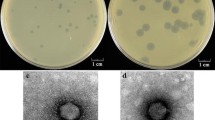Summary
The frequency of occurrence and the genetic structure of polylysogens were studied for phages λ, ⊘80 and λatt80. In the case of λ, frequency of polylysogenization is high (0.20 to 0.41) with a tandem integration of prophages at the primary att site (attλ). With ⊘80 and λatt80, this frequency is about 10 times lower, and usually one prophage becomes integrated at the primary att site (att80-I) while another (sometimes two others) integrates at one of the secondary sites. At least four secondary att80 sites have been found in wild-type Escherichia coli Footnote 1, two of which (near the his and tolC loci) are preferred. The frequency of secondary integration of ⊘80 and λatt80 does not differ significantly in the wild-type host and in that deleted for the primary att site (0.041 and 0.045, respectively, among surviving cells at an MOI of 10).
Homoimmune superinfection has revealed a constitutive cI-independent expression of the ⊘80 int gene in the prophage state. The only ⊘80 tandem detected proved to be unstable. With the ⊘80int - mutant, we observed stabilization of ⊘80 tandems; as a consequence, their frequency of occurrence during coinfection with ⊘80int + was up to the λ level and no nontandem insertions were found. A model is proposed for the ⊘80 and λatt80 nontandem integration.
Similar content being viewed by others
Notes
By the \ldwild type\rd we mean strains with the primary att site
Abbreviations
- TP:
-
transducing phage(s)
- PFU:
-
plaque-forming units
- PC:
-
pink λ clear-resistant colonies on EMBO plates
- MOI:
-
multiplicity of infection
- O :
-
origin of Hfr transfer
References
Arber W (1960) Polylysogeny for bacteriophage lambda. Virology 11:250–272
Bachmann BJ, Low KB, Taylor AL (1976) Recalibrated linkage map of Escherichia coli K-12. Bacteriol Rev 40:116–150
Bachmann BJ, Low B (1980) Linkage map of Escherichia coli K-12. Edition 6. Microbiol Rev 44:1–56
Bertani G (1962) Multiple lysogeny from a single infection. Virology 18:131–139
Bertani LE (1971) Stabilization of P2 tandem double lysogens by int mutations in the prophage. Virology 46:426–436
Bertani G, Six E (1958) Inheritance of prophage P2 in bacterial crosses. Virology 6:357–381
Campbell A, Zissler J (1966) The steric effect in lysogenization by bacteriophage lambda. Virology 28:659–662
Freifelder D, Kirschner I (1971) The formation of homoimmune double lysogens of phage λ and segregation of single lysogens from them. Virology 44:633–637
Gottesman M, Weisberg R (1971) Prophage integration and excision. In: Hershey AD (ed) The Bacteriophage Lambda. Cold Spring Harbor Lab, Cold Spring Harbor, New York, pp 113–139
Gottesman ME, Yarmolinsky MB (1969) The integration and excision of the bacteriophage lambda genome. Cold Spring Harbor Symp Quant Biol 33:735–747
Harris JD, Helling JS, Martinez II, Calendar R, Isaksson LA (1978) Temperature-sensitive Escherichia coli mutant producing a temperature-sensitive σ subunit of DNA dependent RNA polymerase. Proc Natl Acad Sci USA 75:6177–6181
Ilyina TS, Zvorykina NM, Nechaeva EV, Svarchevsky AN, Rybchin VN (1977) Preferable secondary attachment site of prophage ⊘80 on the chromosome of Escherichia coli K-12. Genetika (Moskva) 13:1809–1820
Kholodii GYa, Mindlin SZ (1984) Integration of bacteriophages λ and ⊘80 in wild-type Escherichia coli at secondary attachment sites. I. Formation of secondary lysogens. Mol Gen Genet 197:104–108
Luria SE, Fraser DK, Adams JN, Burrous JW (1958) Lysogenization, transduction and genetic recombination in bacteria. Cold Spring Harbor Symp Quant Biol 23:71–82
Mousset S, Thomas K (1969) Ter, a function which generates the ends of the mature λ chromosome. Nature 221:242–244
Rybchin VN (1984) Genetics of bacteriophage ⊘80—a review. Gene 27:3–11
Shimada K, Campbell A (1974) Int-constitutive mutants of bacteriophage lambda. Proc Natl Acad Sci USA 71:237–241
Author information
Authors and Affiliations
Additional information
Communicated by D. Goldfarb
Rights and permissions
About this article
Cite this article
Kholodii, G.Y., Mindlin, S.Z. Integration of bacteriophages λ and ⊘80 in wild-type Escherichia coli at secondary attachment sites. Mol Gen Genet 198, 491–496 (1985). https://doi.org/10.1007/BF00332945
Received:
Issue Date:
DOI: https://doi.org/10.1007/BF00332945




